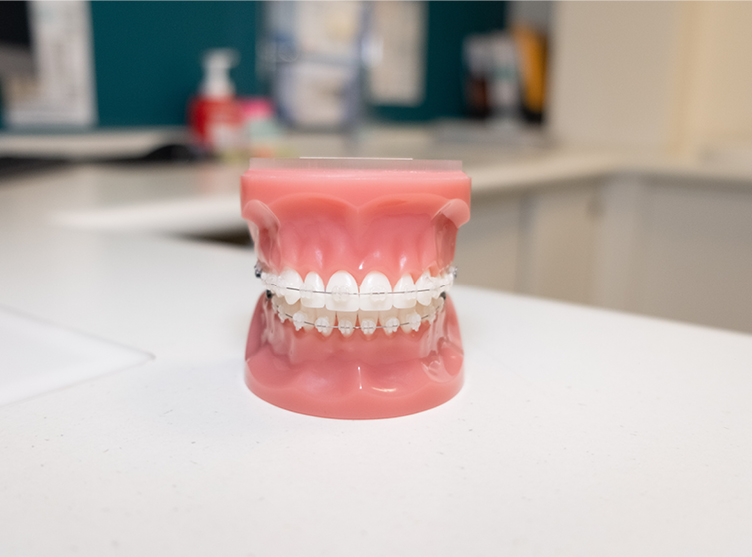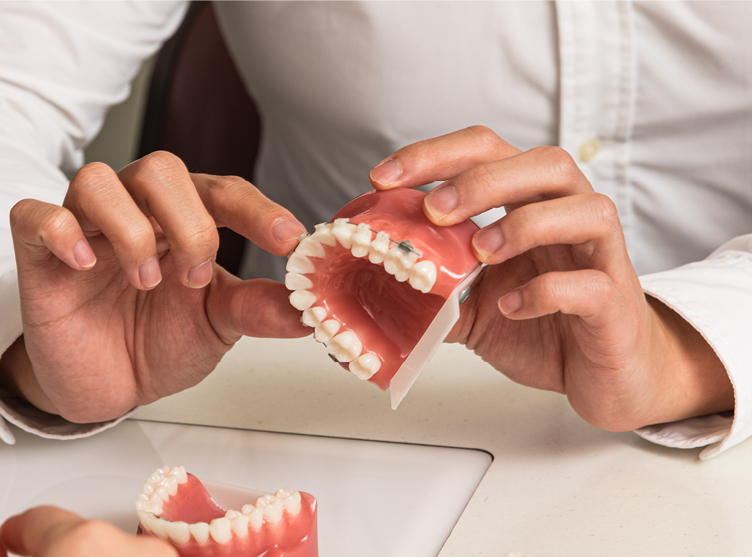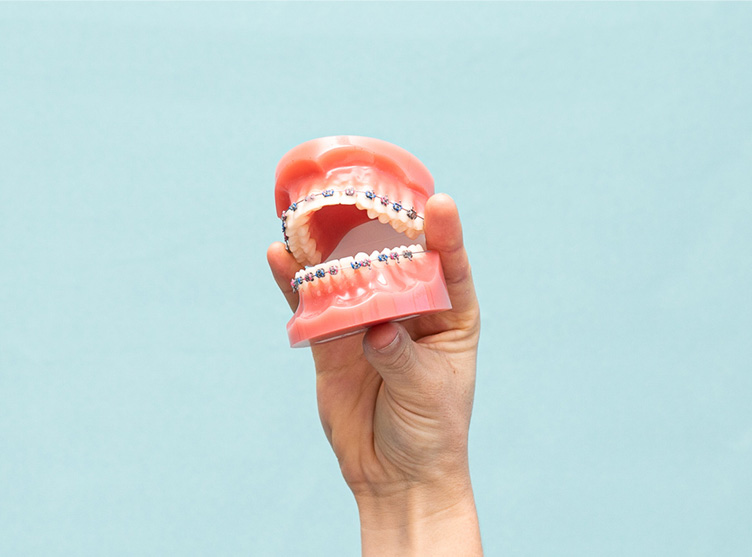Choosing the right type of braces can feel overwhelming — especially when balancing effectiveness, comfort, and appearance. For many teens and adults alike, ceramic braces offer a more discreet alternative to traditional metal braces. But are they just as effective? And how do they compare in terms of cost, durability, and long-term results?
In this comprehensive guide, we’ll walk you through the key differences between ceramic and metal braces, highlight the pros and cons of each, and help you decide which option aligns best with your lifestyle and smile goals.
If you’re currently considering orthodontic treatment, we strongly recommend you to explore our orthodontic braces options or speak with one of our experienced orthodontists. A consultation will provide you with tailored advice, helping you make an informed decision about your orthodontic treatment.
What Are Ceramic Braces?
Ceramic braces, a discreet alternative to traditional metal braces, are fixed orthodontic appliances designed to straighten teeth and correct jaw misalignment. The main distinction lies in the material: instead of stainless steel, ceramic braces are made from translucent or tooth-coloured porcelain or polycrystalline ceramic. This unique feature makes them far less visible on the teeth, a major draw for adults and teens seeking a discrete appearance.

Ceramic brackets are typically bonded to the front of each tooth and connected by an archwire. The brackets may be held in place with clear ligatures (elastics), which are replaced during regular appointments to maintain hygiene and aesthetics.
Who Is Best Suited to Ceramic Braces?
Ceramic braces are suitable for most patients with mild to moderate orthodontic concerns, including crooked teeth, gaps, crowding, and some bite misalignments. They’re often chosen by:
- Adults in professional or public-facing roles
- Teens concerned about appearance during treatment
- Patients with metal sensitivities (ceramic is hypoallergenic)
- Individuals seeking a more discreet alternative to traditional metal braces
However, ceramic braces may not be ideal for patients with severe crowding or complex bite issues, where additional durability and strength are needed.
Book an orthodontic consultation to find out if ceramic braces are the right fit for your needs.
Benefits of Ceramic Braces
Here are some of the most notable advantages of ceramic braces:
✅ Aesthetically Discreet
The primary benefit is their near-invisible appearance. Ceramic brackets are either clear or closely match your natural tooth colour, helping them blend seamlessly with your smile.
✅ Comfortable Fit
Thanks to their smoother surface and rounded edges, many patients find ceramic brackets gentler on the lips and cheeks compared to metal.
✅ Effective Treatment
Ceramic braces offer the same level of orthodontic correction as metal braces when used for appropriate cases. They work through the same mechanism of archwire tension and bracket adjustments, ensuring effective treatment.
✅ Hypoallergenic Option
Unlike stainless steel brackets, ceramic materials do not typically trigger allergic reactions, making them a safer choice for some patients.
Potential Drawbacks to Consider
While ceramic braces offer many benefits, they do come with a few trade-offs:
❌ Higher Cost
Due to the materials used and the extra precision required for placement, ceramic braces are generally more expensive than metal ones. Treatment costs in Australia typically range from $5,500 to $9,500, depending on the severity and duration of the condition.
Please see our FAQ section and payment options for more information.
❌ Susceptibility to Staining
While the ceramic brackets themselves are stain-resistant, the clear elastic ligatures (o-rings) can discolour over time — especially with foods containing curry, turmeric, soy sauce, or red wine. Fortunately, these are replaced at each orthodontic visit.
❌ Fragility
Ceramic brackets are durable but more brittle than their metal counterparts. They’re more prone to chipping or breaking if exposed to excessive force or if patients bite into hard foods.
How Do Ceramic Braces Work?

The process for ceramic braces closely mirrors that of traditional braces:
- Assessment & Planning: An orthodontist evaluates your teeth and bite, often using digital scans and X-rays.
- Bracket Placement: Clear or tooth-coloured brackets are bonded to each tooth using dental adhesive.
- Archwire Installation: A thin wire is threaded through the brackets, applying gentle, continuous pressure to move teeth into alignment.
- Regular Adjustments: Every 4–6 weeks, you’ll return for adjustments, during which time wires may be tightened and ligatures replaced.
- Retention Phase: After treatment, you’ll wear a retainer to maintain the new alignment.
Learn more about orthodontic treatment pathways and what to expect during each stage.
How Do Ceramic Braces Compare to Metal Braces?
Both ceramic and metal braces are effective orthodontic solutions. They operate using the same fundamental mechanism — brackets, archwires, and periodic tightening to gradually shift teeth into place. However, they differ significantly in other areas:
| Feature | Ceramic Braces | Metal Braces |
|---|---|---|
| Appearance | Tooth-coloured or clear; blends with teeth | Silver metal; more visible |
| Durability | More fragile; prone to chipping | Highly durable and less prone to damage |
| Treatment Time | May be slightly longer due to more friction | Generally slightly quicker for complex cases |
| Cost | Higher cost due to materials and aesthetics | More affordable |
| Suitability | Best for mild-to-moderate cases | Suitable for all levels of orthodontic needs |
| Comfort | Smooth surface, gentle on cheeks | May cause more irritation initially |
Metal braces remain the most affordable and durable option, especially for younger patients or those with complex orthodontic needs. Ceramic braces, on the other hand, provide a more discreet and comfortable experience for those prioritising aesthetics.
Common Questions About Ceramic Braces

How long do ceramic braces take?
Treatment duration typically ranges from 18 to 30 months, depending on the complexity of your case and how consistently you follow your orthodontist’s instructions. While some cases may align in a similar timeframe as metal braces, others may take slightly longer due to increased friction between the archwire and ceramic brackets.
Do ceramic braces stain easily?
The ceramic brackets themselves are resistant to staining, but the elastic o-rings can discolour. To reduce staining:
- Brush after meals.
- Avoid strongly pigmented foods and drinks.
- Schedule regular check-ups and adjustments.
Your orthodontist will change the elastics at each visit to help maintain a clean appearance.
Are ceramic braces painful?
Like all braces, you may experience some discomfort after placement or adjustment. This typically subsides within a few days. Many patients report that ceramic brackets feel smoother and less irritating to the inside of the mouth than metal alternatives.
Cost of Ceramic Braces in Australia
In Australia, ceramic braces usually cost between $5,500 and $9,500, depending on the treatment’s complexity, duration, and provider. This price generally includes:
- Regular orthodontic appointments
- Diagnostic imaging
- Bracket placement
- Ongoing adjustments
- Post-treatment retainers
Private health insurance with orthodontic cover may offset part of the expense. Many clinics also offer interest-free payment plans to make the process more accessible.
Ready to explore your options? Contact Smile Team for a personalised consultation and quote.
Should You Choose Ceramic Braces?
Ceramic braces are ideal for patients looking for a less visible orthodontic treatment without compromising effectiveness. They are especially popular with:
- Working professionals
- Older teens
- Adults preparing for life events (e.g. weddings, graduations)
- Patients with metal allergies
However, those with severe misalignment, sports-related risks, or budget constraints may benefit more from traditional metal braces.
Final Thoughts: Ceramic or Metal Braces?

Ultimately, the best type of braces depends on your personal goals, oral health, budget, and orthodontist’s recommendation.
| Choose Ceramic Braces If You… | Choose Metal Braces If You… |
|---|---|
| Want a discreet appearance | Need a budget-friendly option |
| Are committed to excellent oral hygiene | Have more complex dental misalignment |
| Have mild to moderate alignment issues | Prefer a faster treatment in some cases |
| Are willing to invest a bit more | Don’t mind the more visible appearance |
Whichever option you choose, the most important step is consulting a qualified orthodontist. At Smile Team, we’ll work with you to determine the best treatment for your needs and lifestyle.
Book Your Orthodontic Consultation
Begin your smile journey with expert guidance. Whether you’re considering ceramic braces, metal braces, or another treatment option, such as clear aligners, our friendly orthodontic team is here to help you make the right choice.